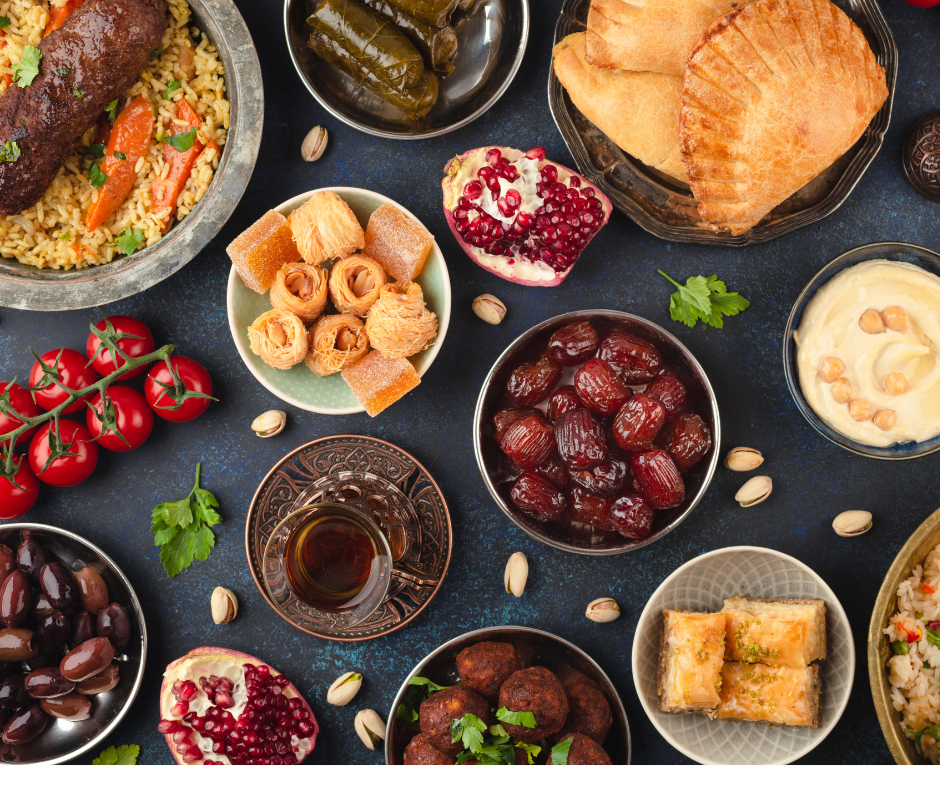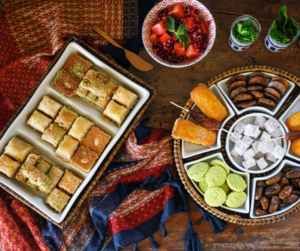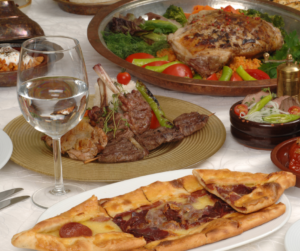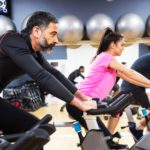Fueling your training sessions during Ramadan requires a balanced approach to nutrition.
To maintain energy levels and support your recovery you need to consume complex carbohydrates, lean sources of protein, a variety of fruit & veg, stay well hydrated, and listen to your body to adjust your training intensity as required.
Here’s a nutritional guide to teach you how to fuel your workouts with nutritious foods while fasting during Ramadan…

Suhoor & Iftar
Suhoor is the pre-dawn meal and Iftar is the meal consumed at sunset.
For suhoor, you must drink enough water to keep you well hydrated the entire day. You should consume a good combination of protein, carbohydrates, fruit, and vegetables.
If you would like to train in the mornings then we recommend consuming a small bowl of oats, or some toast with peanut butter, and a handful of dates or even a protein shake with banana and then doing your training but completing it with enough time to have an after training meal and drink before the sun rises.
When breaking your fast at Iftar it’s important to remember to do so slowly, you will feel ill if you eat lots of food and drink lots of water all at once.
We recommend breaking your fast with a small light meal and some water. Soup and some bread is a good example and then if you need to train then do so after the small meal then after training has your bigger meal.
Let’s break down what exactly a nutritious meal for someone training in Ramadan consists of…
How To Break The Fast At Sunset and Sunrise
Beginning of fast:
- Wake up early
- Weigh yourself
- Light exercise in the morning
- Reduce training as much as possible in the afternoon
- Avoid exposing yourself to sunlight
- Keep yourself cool during the day by taking showers or going swimming
- During the training sessions during the day, wear light-colored, loose, and lightweight clothes (fabrics that allow sweat evaporation) and a lightweight cap of a light color.
End of fast:
- Weigh yourself prior to the meal. This will give you an indication of your hydration levels.
- Drink small sips until your stomach is comfortable. Then increase to drink at least the equivalent of the weight you lost during the day.
- Include foods that are rich in water such as milk, smoothie, vegetable juice, and soups.
- Eat small amounts initially and follow up with a bigger meal.
- Train with carbohydrates and fluids during the session.
- Have a bigger meal after training.
- Limit fatty foods and very sweet food.
- For the main meal, have a lean protein, e.g. skinless chicken, beef, veal, or fish kebab, combined with starchy foods and vegetables.
- Desserts with couscous, fresh, and dried fruit.
- Avoid stimulants such as coffee, tea, sodas, and energy drinks
Foods To Eat When Breaking The Fast

Iftar
- Most traditional dishes served at iftar are good sources of carbohydrates (like figs) and high-quality proteins (e.g. milk).
- When the exercise is planned just before iftar, these dishes can be consumed as post-exercise recovery snacks and may be followed by another training session and another meal.
- High-quality proteins are necessary for recovery after resistance sessions and must be part of the iftar meal or snack.
- You should take advantage of the possibility of drinking and eating during exercise performed after sunset. This will enhance your performance during training and will also contribute to achieving your nutritional goals.
- Sports foods, such as energy gels, drinks, and bars, are nutritious concentrates that are easy to ingest in these situations.
Suhoor (Pre-dawn meal)
- Eat as close as possible to sunrise and choose foods that contribute to sports nutrition needs for the day.
- Base the meal on carbohydrate sources such as starches and fruits or dried fruits.
- Include protein sources with a slow release.
- Include food rich in water such as fruit juice, milk, smoothies, and fresh fruit.
- Support needs for performance and recovery.
Let’s have a look at a few more meal examples…
Examples Of What To Eat When Breaking The Fast
At least one hour before starting training, favor easily digestible food such as
- Cereal bar
- Slice of gingerbread
- Rusk
- Fruit puree
- Plain yogurt
- Many common foods associated with Iftar are rich in carbohydrates (e.g. figs/dates) and high-quality protein (milk and laban yogurt).
- The substantial meal after prayers typically features savory dishes with carbohydrate-rich components (rice) and protein (meat or fish)
- Arab breads and other varieties provide worthwhile amounts of carbohydrates.
- In the context of South African Muslims, most break fast with savories like Samoosas and pies.
- Dates are an inherent part of their religion and are consumed a lot during the fasting month,
- Other combinations of carbohydrates and protein include Thareed (bread containing), starch pudding (milk), and rice porridge
- Care should be taken with Ramadan treats, since many are very high in fat. Some recipes can be adapted to promote carbohydrate content and reduce fat (e.g. replace puff pastry in Um Ali with bread)
- Ma’amoul, dried fruits, and nuts are suitable snacks
- When eating opportunities are limited, drinks with high energy/nutrient density can be useful to meet high-energy requirements. These include special nutrient feeds used in clinical nutrition situations, liquid meal supplements, and fruit/milk smoothies
- Many of the special Ramadan drinks (e.g. Jellab) are energy-rich and those based on milk/laban also provide high-quality protein
- Suhoor meals that are high in carbohydrates include rice with egg, cheese, and milk. Beans and foul while good sources of many nutrients may not be suitable if consumed close to a training session
Note: With the advent of the air fryer to modern kitchens, many health-conscious Muslim homemakers are now air frying their samoosas and savories to reduce fat and oil content… but in some circles, people are highly offended to be eating such samoosas.
Now that we know exactly how to manage our nutrition during Ramadan, let’s have a look at our hydration strategy…
How To Ensure Correct Hydration During Ramadan
- It is unlikely that mild dehydration associated with Ramadan will negatively affect short-term exercise, i.e. under one hour.
- This may not be the case during longer-duration events especially if these events take place in high ambient conditions.
- Athletes during Ramadan should make increased efforts to ensure that exercise is commenced euhydrated and that rehydration occurs as soon as it is feasibly possible.
- This is really only a problem when exercise is performed prior to the Iftar meal.
- It may also be an option to utilize cold mouthwashes during exercise to help prevent feelings of thirst, however, this again will require discussion with religious authorities.
- It is important to remember that rehydration should not only be focused on the restoration of fluids but also must consider the specific electrolytes that will be lost especially sodium.
- This may involve the addition of electrolytes to fluids especially if athletes have performed prolonged exercise in the heat prior to the Iftar meal.
- Drinking sufficient fluids from Iftar until Suhoor is crucial while taking into consideration the need for additional electrolytes. This can be done either by drinking rehydration solutions or by drinking and eating at the same time. This will help your body to retain water.
- It should be noted that it would be unwise to attempt to hyperhydrate by drinking copious amounts of water at the Suhoor meal as this can lead to prompt diuresis and ultimately could contribute to further dehydration.
- Athletes can easily determine whether their hydration plan is sufficient to balance their losses by checking body weight, and monitoring the color and amount of urine produced, especially in the morning (urine should be clear and of a normal volume).
- Strategies to reduce sweating should be used. For example, avoid senseless exposure to heat or sun. In addition, consider using “cooling vests”, cold baths, fans, etc. during and after the effort, especially if you are performing in a hot atmosphere.

The key considerations for nutrition include maintaining energy balance, consumption of an athletic-specific quantity and distribution of macronutrients, and maintaining euhydration (or at least preventing severe hypohydration).
It is important to consider the 3 Ts: Total, Type, and Timing of nutrition intake…
Total and Type of Nutrition To Be Consumed During Ramadan
Ensure adequate energy intake
If trying to maintain a high training load or if you are planning any races during Ramadan, ensure a high carbohydrate intake (6-10 g/kg body mass).
This should be achieved predominantly during the Iftar with some contribution during the Suhoor.
There may be benefits from the deliberate switch to some high GI and low residue carbohydrate sources to help with gastrointestinal discomforts, such as canned fruit, fruit juice, white bread, and cereals with low fiber content.
Liquid carbohydrate intake can also help if energy requirements are very high, such as sports drinks or fruit juice.
Consume at break of fast and meal before dawn, and other meals during the evening, especially where these meals represent post-, pre-, or in-exercise intake.
Set targets according to the fuel cost of exercise.
Consume small amounts during exercise undertaken after the fast is broken, even if there is little need for additional fuel. Mouth contact with carbohydrates may promote a ‘‘happier’’ brain for better performance, especially if otherwise fatigued.
Eat immediately after exercise if possible to enhance the refueling rate. Consume low glycaemic carbohydrate choices at meals consumed before dawn to allow slow release of glucose
Adequate protein intake (~1.6 g per kg body mass per day) to maximize muscle protein synthesis and promote muscle growth and repair.
For smaller endurance athletes weighing approximately 50kg, this would be easily achieved in the 2 main meals, however, this may present a challenge for larger athletes. Larger athletes can explore the use of protein shakes, including a slow-releasing casein shake.
Consume 20 g ‘‘fast’’ high-quality protein soon after exercise where possible, but note that enhanced protein synthesis from exercise persists for 16–24 h
In absence of information on the best protein spread over the day, consume protein at each meal opportunity (avoid eating only carbohydrate-rich food choices).
Consume ‘‘slow’’ proteins at meals consumed before dawn to help with protein balance over the day.
Add protein to carbohydrate-rich snacks to enhance muscle glycogen storage when carbohydrate targets can’t be met.
Timing Of Nutrition Intake During Ramadan
Reserve daytime training for technical, tactical, and light sessions. Do higher intensity sessions or strength sessions closer to or even following the Iftar
Post-training protein feeding results in the most favorable anabolic environment for muscle growth and repair.
Theoretical feeding and training structure:
- Protein is distributed throughout the day including immediate post-training (achieving 4 x 0.4g/kg).
- Carbohydrates are to be provided before and after ‘high intensity’ sessions (achieving 6-8g/kg).
- Slow-releasing proteins pre-bed and pre-fast to give a more sustained supply of amino acids to facilitate recovery.
Example:
5h00 Final pre-dawn meal (Suhoor)
- Carbohydrate (2 g/kg)
- Protein (0.4 g/kg)
- Yogurt with fruit; toast with egg and grated cheese and fruit juice
6h00
- Slow-release protein (0.4 g/kg), e.g. casein
- Milk, yogurt (casein)
6h30
- Sunrise
- Beginning of fast
9h00 – 14h00
- Preferable light training sessions
14h00 – 18h00
- Resting preferred
- Nap if possible
19h00 Sunset
- Post-sunset recovery shake containing 1 g/kg carbohydrate and 0.4 g/kg protein to break the fast
- Meal replacement shake, recovery shake, or smoothie with milk/yogurt, fruit, and peanut butter or protein powder
- Follow up with strength or high-intensity training
Here at Coach Parry, we’re massive advocates of strength training. We’ve put together this free strength training plan for runners that you can do once a week, at home and with no expensive equipment needed. You can access it by clicking here.
19h30 – 20h00 Iftar
- Iftar meal containing 4 g/kg carbohydrate and 0.4 g/kg protein
- Chicken, fish, or beef served with rice, legumes, and vegetables. Add fluid to the meal, e.g. drinking yogurt, milk, fruit juice, or cordial.
22h00
- Slow-release protein containing 0.4 g/kg protein with some carbohydrates alongside (1 g/kg body mass)
- Yogurt with fruit and nuts or seeds OR Cereal and milk OR Peanut butter sandwiches with banana and milk
To summarise nutrition, let’s have a look at common mistakes made during Ramadan with regard to nutritional intake…
Common Nutritional Mistakes Made During Ramadan and Suggested Strategies
| MISTAKE | RATIONALE | SOLUTION |
| Drinking inconsistent amounts of fluid between Iftar and Suhoor, followed by a large amount of fluid before dawn (Suhoor time). | The body may not be able to efficiently store the water consumed and may even increase urine output in the acute period following. | The best practice may be to consume 2000-3000 ml, non-excessively, over the non-fasting periods (Iftar and Suhoor meal times) and ensure that any loss of body mass has been corrected. |
| Eating salty food during the Suhoor meal. | Sodium may be beneficial for fluid retention, however, consuming excess amounts of salt prior to dawn may result in increased thirst sensation throughout the day. | Try to choose non-processed foods that may be high in sodium and consider adding less table salt to meals. |
| Drinking high-energy calories on light training days. | Excess caloric intake, including through fluids such as carbohydrate-dense fruit juices, may lead to weight gain and accumulation of fat mass during this month. | Consider the training demands of the day and if high carbohydrate intakes are not required focus on water as the main fluid option. |
| Eating excessive food during the Iftar meal. | Consuming large amounts of food during the first meal after long periods of fasting can lead to indigestion and may affect sleep. | Consider consuming smaller easily digestible meals as this may help. |
| Missing the Suhoor | Missing a Suhoor meal may lead to lower energy and increased hunger the next day. | Having Suhoor and consuming slow digestion macronutrients will lead to better energy levels the next day, and more controlled hunger. A slow-release casein shake may also help. |
There are always concerns when it comes to fasting and health, so let’s have a look at some common questions with regard to fasting…
How Does Fasting Affect Health?
Overall, the balance of evidence suggests that from a general health perspective, there are no major health issues following Ramadan and there may even be health advantages.
The health benefits of intermittent fasting have been associated with positive changes in hormonal responses, oxidative stress, and inflammation.
SAFE & EFFECTIVE Training During Ramadan: A Comprehensive Guide
How Does Fasting Affect Body Composition?

Research on body composition during Ramadan has actually shown that body fat may decrease, maintain or even increase dependent upon the actual diet consumed during this time.
Remember that Ramadan fasting does not always result in energy deficits.
If there is a high intake of energy-dense food and drinks (such as deep-fried food and food and drinks with high sugar content) during the feeding period, there can be unwanted gains in body fat.
Providing that nutrition support is provided, athletic body composition can be maintained throughout Ramadan.
How Does Fasting Affect Performance?
Given the fundamental role that pre-, during and post-nutrition plays in athletic performance, it would appear logical that prolonged periods of fasting would have major detrimental effects on both training and competitive performance.
The aspects of performance that are vulnerable particularly refer to repeated high-intensity efforts.
However, research tends to suggest that performance can largely be maintained during Ramadan, via careful consideration of the training loads, time of training, and nutrition in the permitted non-fasting periods.
The key takeaways are that during Ramadan, it’s important to eat a balanced diet including foods high in fiber, protein, and complex carbohydrates for sustained energy.
Hydration is vital, especially with water and fluid-rich foods before sunrise and after sunset. Avoid overeating, sugary, processed foods, and be mindful when training by listening to your body and adjusting your nutrition, hydration, and training accordingly.



Comments are closed.